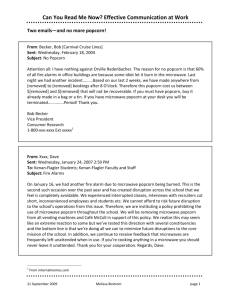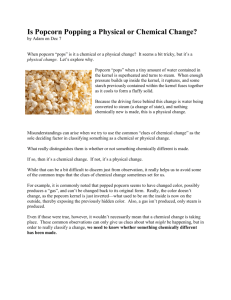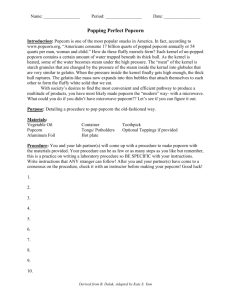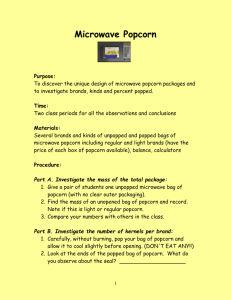How Dense Is Your Soda
advertisement
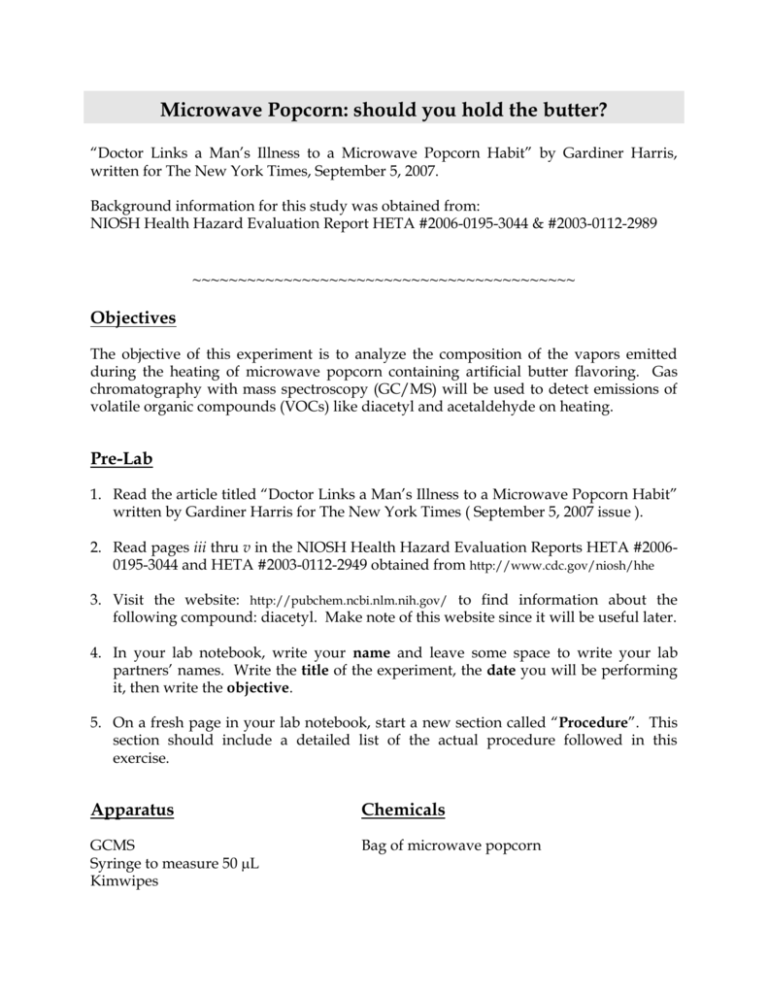
Microwave Popcorn: should you hold the butter? “Doctor Links a Man’s Illness to a Microwave Popcorn Habit” by Gardiner Harris, written for The New York Times, September 5, 2007. Background information for this study was obtained from: NIOSH Health Hazard Evaluation Report HETA #2006-0195-3044 & #2003-0112-2989 ~~~~~~~~~~~~~~~~~~~~~~~~~~~~~~~~~~~~~~~~~~ Objectives The objective of this experiment is to analyze the composition of the vapors emitted during the heating of microwave popcorn containing artificial butter flavoring. Gas chromatography with mass spectroscopy (GC/MS) will be used to detect emissions of volatile organic compounds (VOCs) like diacetyl and acetaldehyde on heating. Pre-Lab 1. Read the article titled “Doctor Links a Man’s Illness to a Microwave Popcorn Habit” written by Gardiner Harris for The New York Times ( September 5, 2007 issue ). 2. Read pages iii thru v in the NIOSH Health Hazard Evaluation Reports HETA #20060195-3044 and HETA #2003-0112-2949 obtained from http://www.cdc.gov/niosh/hhe 3. Visit the website: http://pubchem.ncbi.nlm.nih.gov/ to find information about the following compound: diacetyl. Make note of this website since it will be useful later. 4. In your lab notebook, write your name and leave some space to write your lab partners’ names. Write the title of the experiment, the date you will be performing it, then write the objective. 5. On a fresh page in your lab notebook, start a new section called “Procedure”. This section should include a detailed list of the actual procedure followed in this exercise. Apparatus Chemicals GCMS Syringe to measure 50 L Kimwipes Bag of microwave popcorn Procedure 1. In your lab notebook make sure to write the brand and type of microwave popcorn that you were assigned to analyze. 2. Familiarize yourself with the different parts of the GC/MS instrument. Your instructor will point out the major components of the instrument. Write down the instrument’s model and parameters used for this particular experiment. 3. Use a microwave to prepare the popcorn according to the instructions in the package. 4. While the bag is still warm you should use a syringe to poke a hole through the top of the bag. Try not to “stab” any of the actual popcorn, but to just collect a sample of the vapors above the popcorn kernels. Leave the needle inside the bag and pump vapors in and out of the syringe a couple of times to fill the syringe with “popcorn vapors”. Collect about 50 L of gas sample. 5. Quickly inject the sample into the injection port. Your lab instructor should guide you through this step. 6. As soon as you are done with the injection, make sure pump the syringe needle several times so as “rinse out” residual contamination in the syringe. 7. Collect copies of the GC spectrum and MS spectrum. Each member of your team should have copies. Also use the chemical library on the computer to identify at least 5 compounds present in the detected peaks. Data This section of your lab notebook should include the GC and MS spectra. Prepare tables that summarize and analyze the GC and MS spectra. Prepare a table that lists at least five components that were found in the injected sample. For each compound include its chemical formula, chemical structure, formula weight, boiling point and elution time. Find information about their adverse effects or toxicity in lab animals and/or humans. Your lab instructor can provide you with reliable sources of information that can be accessed online (http://pubchem.ncbi.nlm.nih.gov/). . Formal Report You will be responsible for typing a complete summary of this lab exercise. You will need to include a general description of the purpose of this lab, what type of sample was injected into the GC/MS, how does a GC/MS works and what type of information it provides, what did you find out about microwavable popcorn, and based on the results: what would be your recommendation to consumers who like to eat microwave popcorn. Below is a list of information that should be included in your written report at some point. Remember to first prepare an outline to organize the information so that it flows logically and clearly from one sentence to the next. 1. The sample that was injected into the GC/MS was it a pure element, pure compound, homogeneous mixture or heterogeneous mixture? Explain your reasoning. 2. Briefly but clearly explain what happens in the GC component of the instrument when the sample is injected. What gas is constantly flowing through the GC? Why is this specific gas used rather than using good old fashion “air”? 3. Provide an explanation of what happens to the sample when it travels through the MS component of the instrument. 4. Describe in general what is plotted in a GC spectrum. Your description should include what is plotted along the x- and y axis. 5. Describe in general what is plotted in a MS spectrum. Your description should include what is plotted along the x- and y axis 6. The nutritional label of a microwave popcorn bag lists sodium as one of the main components in the prepared popcorn. Did the GC/MS detect this sodium? Why or why not? 7. What conclusion have you made about the vapors emitted during the preparation of microwave popcorn with artificial butter flavoring. References In your formal report, cite all the complete references used. Also include any online resources used to find information relevant to this lab. Grading Your instructor will collect the yellow carbon copies from your lab notebook and the typed formal report. Make sure you include paper copies of any GC/MS spectra relevant to this lab experiment. Your report needs to show that you clearly understand the chemical concepts that were relevant to this lab and that you know how to communicate this knowledge in a neat, clear, and thorough manner.

